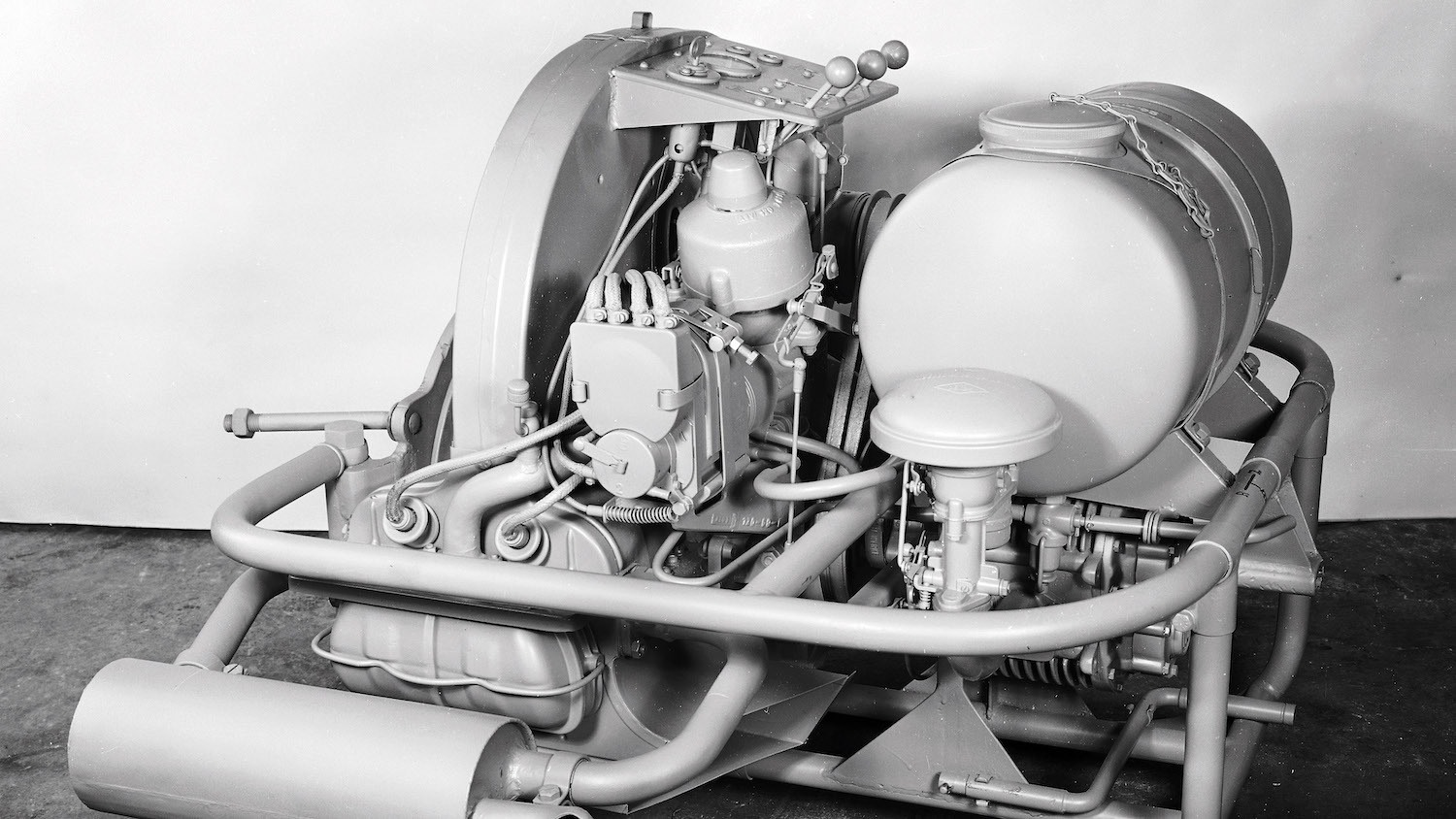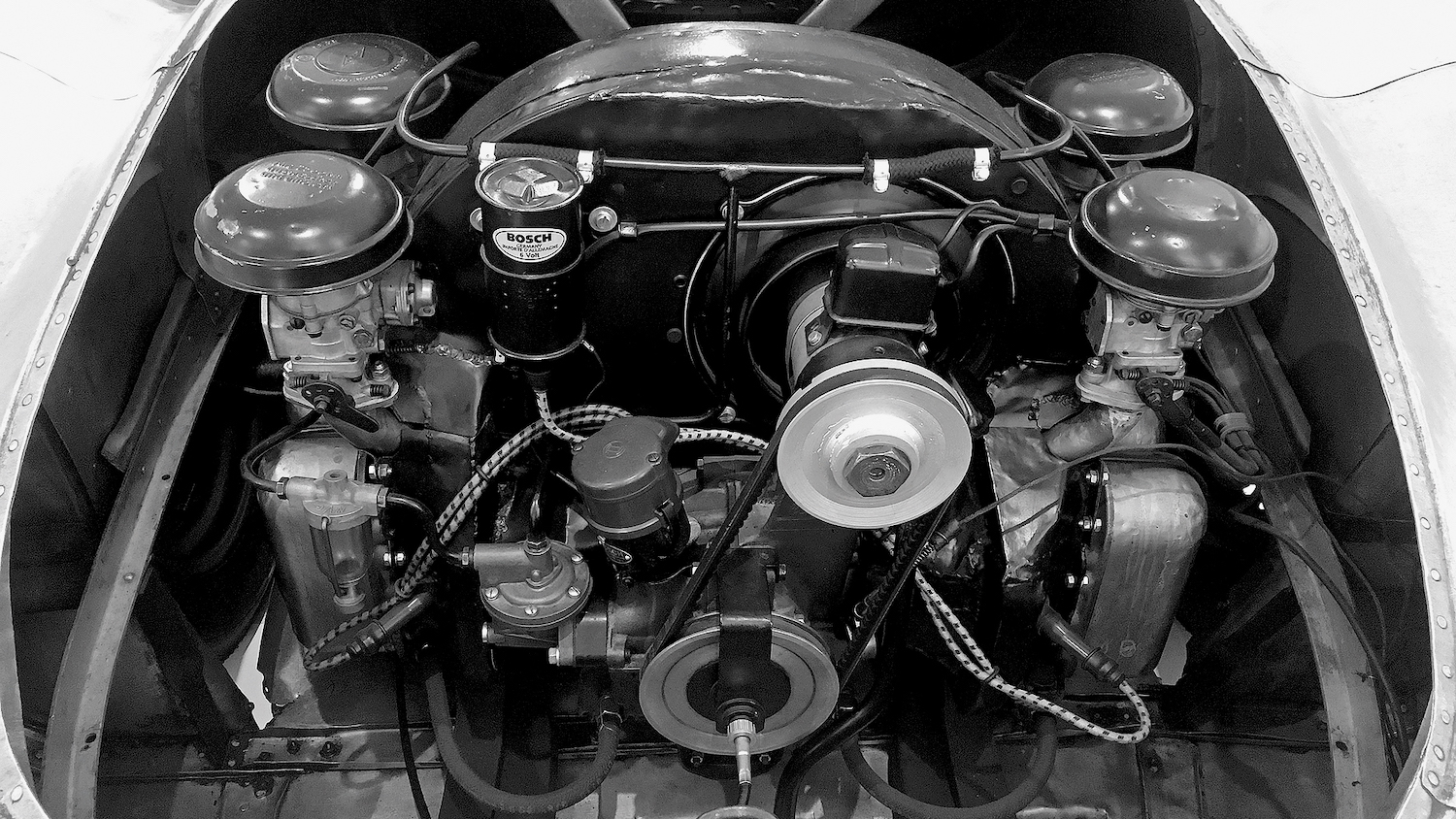The powerful engine Porsche couldn’t put into the 356
The design filed under No. 367 in the archives marks a special chapter within Porsche’s genesis story. It’s a prototype engine tested while Ferry Porsche moved away from the 1939 Porsche Type 64 Berlin-Rome car to his first production 356s, built in 1948 at a former sawmill in Gmünd, Austria.
Porsche’s first car had to be more powerful than a KdF-Wagen Type I, and the Volkswagen-based Type 64 race car’s air-cooled engine already came with bigger valves, dual carburetors, and a higher compression ratio, boosting the flat-four’s peak to 32 horsepower. Yet once Ferdinand Porsche moved his office from Stuttgart to Gmünd, the family business had to be kept afloat by developing and making agricultural equipment, such as cable winches and mowing fingers. This was long before Porsche would get into the diesel tractor genre, and as far as one could get from making sports cars.
However, as Ferry’s father kept working on state-related projects, the younger Porsche kept dreaming big. In 1938, before the war would take over Germany, he came up with plans for the Type 114, a mid-engine sports car powered by a water-cooled twin-overhead camshaft 1.5-liter V-10. Wild, but certainly not unimaginable at the time when Germany put vast resources into chasing land-speed records. Still, with an aerodynamic body inspired by Erwin Komenda’s Type 64 design, this 71-hp race car could have been an absolute revolution in the 1940s, if only history would allow it.

At the same time, Germany demanded more powerful KdF engines from Porsche, having the intention of putting them into assault boats, amphibious vehicles, and anything in between that VW’s robust four-cylinder could push. Design numbers such as 115, 170, 171, and 174 translated to prototypes with larger displacements, bigger valves, turbocharging, hemispherical cylinder heads, and overhead camshafts, with Porsche even testing a valveless variant. Specifically, Porsche’s Type 115 engine came with two overhead camshafts, along with a Roots-type supercharger.

The first post-war Beetles featured 24-hp engines, and the most basic upgrade would have been the Type 366 plan, which included using stock 1131-cc KdF blocks with a pair of Solex 26 VFI carburetors, and an increased compression ratio from 5.8:1 to 7:1. However, the resulting peak output of 39-hp just wouldn’t satisfy the Gmünd team, and so Porsche decided to move on to the mighty Type 367s.
Still based on 1944 blocks, the 367 prototypes featured trick cylinder heads of the following specification:
“The V-position of the vertically arranged valves permitted larger diameters for better gas throughput and a more favourable combustion chamber shape. In addition, a sharper camshaft was used together with a reinforced, three-part valve train and a polished crankshaft. Hand-turned cylinders with dry bushings and smaller pistons ensured that the engine remained under the class limit of 1100 cm³ which applied for motor sports. There is no information in the documentation about the exact power output, but it can be assumed that the high level of design complexity meant that the target of 49 horsepower was easily exceeded. The design number and dates of preserved design drawings (“Bonnet cooling for engine Type 367” on 22 June 1949) indicate that engine development took place parallel to the 356, but was finally discarded once more.”

Porsche made a total of eight such 367 cylinder heads, and based on the engine bay modifications, it’s highly likely that at one point during its active live, a 367 prototype also made it into the Type 64 Berlin-Rome race car. Today, the only publicly displayed survivor is the 367 VW engineer Gustav Vogelsang built for the record car of Petermax Müller. Located at the PROTOTYP Museum in Hamburg, this engine is in running condition to this day.
Finally settling for a viable compromise, the first 50 aluminum-bodied 1948 Porsche 356s built in Austria came with slightly tweaked KdF and Kübelwagen engines. It was only once the company moved back to Stuttgart that 356s were fitted with Type 359 engines, which combined the V-shape valve layout with a single cylinder head per side. At 1086 cc and producing 39 hp throughout most of its rev range, the 369 was the diet 367 fit for post-war Europe—and the bright future that lay ahead.

20200312204715)
20200312204728)
20200312204745)
20200312204806)
20200312204825)
20200312204849)
20200312204905)
20200312204921)
20200312204944)
20200312205001)
20200312205024)

